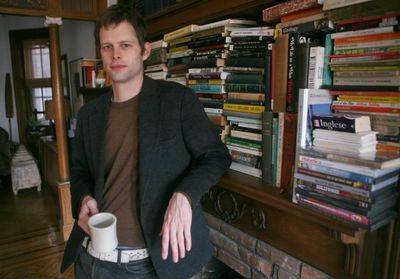‘Lowboy’ wins rave reviews
John Wray delves into schizophrenia in third novel

John Wray, the award-winning young writer of obscure fiction, is adjusting to something entirely new: People buzzing about – and possibly even reading – his book.
The 37-year-old New Yorker wooed critics with two challenging historical novels – 2001’s “The Right Hand of Sleep” and 2006’s “Canaan’s Tongue” – but rarely appealed to readers beyond the bookish types who declared him a literary rock star and under-the-radar talent.
That rock Wray’s been hiding under is being lifted.
After 10 years as a low-selling critical darling, Wray might finally have a breakout hit on his hands. His third novel, “Lowboy,” about a paranoid schizophrenic teenager, is winning rave reviews – no big surprise there – but also loads more buzz than ever, securing profiles in glossy magazines (Esquire, New York) and enthusiastic reviews online.
All the attention feels a bit weird to Wray.
“I’m not going to try and play it down,” he says during a recent interview in his apartment in Brooklyn’s Park Slope neighborhood, a mecca for highbrow authors. “It feels like a real validation for me.”
He looks younger than his years, resembling a 15th-year senior in college with boyish features, a lanky build and casual-cool wardrobe (he wore a blazer that seemed earmarked for special occasions like media interviews and photo shoots).
But Wray, who proved a subpar student and even switched high schools due to dismal grades, has shown remarkable maturity, ambition and imagination on the page.
He was raised in Buffalo, N.Y., the son of an American physician father and Austrian biologist mother. He stands 6 feet 2 inches tall and exudes a sense of calm: Other writers might sweat at the sight of a tape recorder, but not Wray.
“There’s nothing very anxious about him,” said Wray’s editor, Eric Chinski. “He’s obviously very comfortable in the world, and that’s not true of a lot of writers, I think.”
After getting an English degree at Oberlin College and spending time in Alaska and Texas, Wray wrote the first draft of his debut novel, “The Right Hand of Sleep,” while living rent-free in a tent in the basement of a Brooklyn warehouse.
The book, a dark drama set in World War II-era Austria, was a critical home run. It earned Wray both the prestigious Whiting Writers’ Award, bestowed annually to promising literary voices, and also some money to find new digs.
But the acclaim did not translate to book sales. According to Nielsen BookScan, some 4,000 copies have sold to date.
It was the same story with “Canaan’s Tongue.” The dense, twisted novel about a crooked gang of 19th-century slave runners was adored by critics and ignored by casual readers. That one sold less than 1,000 copies.
Enter “Lowboy.” Wray’s attempt at combining art and accessibility melds his daring narrative flourishes with the fast pace, thrills and chills of a sophisticated page turner.
It’s a coming-of-age tale unspooled within a modern-day, 24-hour period: A schizophrenic 16-year-old named Will goes off his meds, escapes his mental ward and finds potentially fatal purpose riding the New York subway.
Meanwhile, his mother and a police detective embark on a frantic search for the boy before the worst happens.
In brainstorming the idea, Wray was initially inspired by an Australian news story about an urgent manhunt for a dangerously disturbed man on the loose in the Sydney transit system.
But the concept became more personal when he looked back on childhood friends, especially an “extremely charismatic” high-school classmate, who later developed mental illnesses.
“Even though it was a project that I began in a fairly sort of cavalier way, over time it really started to obsess me and I realized the question of sanity and insanity is something that I’ve really been kind of obsessed with for a long time,” Wray says.
“Of all the books I’ve written, this was one I was most absorbed in as I was working on it.”
His preparation included visiting psych wards and observing the underground subway scene frequented by homeless schizophrenics who are “happy to talk about what they’re going through.”
Wray wrote much of the book on the subway, like a Method actor staying in character between takes.
“I didn’t procrastinate half as much,” he says. “I got things done more quickly because I didn’t have much in the way of distraction down there.
“All you need is a really good pair of headphones – not the earbuds, but the comfortable big ones – that also shut out a lot of noise. And you need a good playlist on your iTunes or whatever.”
Farrar, Straus and Giroux released “Lowboy” last month and has ordered up three printings. Kathy Daneman, a representative for the publisher, says they are “extremely pleased with how it’s been selling.”
So far, the book has pushed some 3,000 hard covers, according to Nielsen data.
Wray – who promoted “Canaan’s Tongue” by rafting down the Mississippi River – got equally creative for his latest promotional stunts.
He filmed a viral video that shows a hodgepodge of subway riders reciting excerpts from the book’s first chapter. And he conducted a reading of “Lowboy” on the Brooklyn-bound L train.
In that reading, which can be viewed on YouTube, Wray speaks through a bullhorn, not appearing nervous despite the awkward mix of in-the-know fans and commuters probably wondering what the heck is going on.
His rush-hour reading pauses between stops and is interrupted by both subway announcements and the warning “Stand clear of the closing doors, please.”
“Next stop is our stop, everybody, just so you know,” he tells his audience at one point. “I think that’s good news for the rest of the riders on this train.”